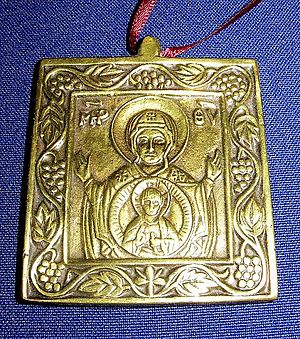Solemnity of Mary, Mother of God facts for kids

The Solemnity of Mary, the Holy Mother of God is a special feast day honoring the Blessed Virgin Mary. It celebrates her role as the mother of Jesus Christ. According to ancient Law, Jesus was circumcised eight days after his birth. Christians believe Jesus is the Lord and Son of God.
The Roman Rite of the Catholic Church celebrates this day on January 1. This is the eighth day after Christmas. This special day is a Holy Day of Obligation for Catholics in many places. This means they are expected to attend Mass. Other Christian groups also honor Mary. Byzantine Catholic, West Syriac, and East Syriac Rites celebrate Mary as the Mother of God on December 26. The Coptic Church (an Oriental Orthodox church) celebrates it on January 16.
The Eastern Orthodox Church, Traditional Catholics, Anglican Communion, and the Lutheran Church observe the Feast of the Circumcision of Christ on January 1.
Contents
Why Mary is Called Mother of God
This feast celebrates Mary being the mother of Jesus. The name "Mother of God" comes from the Latin Mater Dei. This is a translation of the Greek word Θεοτόκος (Theotokos). Theotokos means "Bearer of God." This title was officially accepted by the First Council of Ephesus in 431 AD. It was used to show that Jesus is truly divine, meaning he is God.
How the Feast Day Started
The Second Vatican Council stated that Mary has been honored as the Mother of God since early times. In ancient Rome, the Church celebrated a feast on January 1. It was called the anniversary of the Mother of God. Later, other feasts like the Annunciation and the Assumption became more popular. These feasts were adopted from Constantinople in the early 600s.
Because of this, January 1 started to be celebrated as the eighth day of Christmas. This was the day Jesus was circumcised and given his name, as mentioned in the Bible (2:21).
In the 1200s or 1300s, January 1 began to be celebrated in Rome. It was called the feast of the Circumcision of the Lord and the Octave of the Nativity. Even then, many prayers and songs on this day still honored Mary's motherhood. In 1960, Pope John XXIII changed the calendar. He removed the mention of Jesus' circumcision. January 1 was then simply called the Octave of the Nativity.
The Feast of Mary's Motherhood
A special feast called the Maternity of the Blessed Virgin Mary was first allowed in Portugal in 1751. It was celebrated on the first Sunday in May. Over time, this feast spread to other areas. In 1931, Pope Pius XI extended this feast to the entire Catholic Church. It was then celebrated on October 11.
The Madonna del Parto Statue
In Rome, there is a famous statue called the Madonna del Parto. It is in the Basilica of S. Augustine. For centuries, people have prayed to Mary before this statue. They ask for safe deliveries and healthy babies. The statue is often covered with gifts and surrounded by flowers and candles. Sometimes, there are even photos of happy babies. These show people's faith in Mary's help.
Our Lady of Good Remedy
This feast was also important to the Trinitarians. In 1198, John of Matha started this order. Their goal was to free Christians who were held captive. He asked Mary for help with fundraising. To thank her, he honored Mary with the title "Our Lady of Good Remedy." Her feast day is now celebrated on October 8.
Changes to the Calendar
In 1969, the Church made changes to its calendar. This change, called Mysterii Paschalis, stated that January 1 is the Solemnity of Mary, the Holy Mother of God. It also remembers the day Jesus was given his holy name. The feast on October 11 was removed from the universal calendar. This means the celebration of Mary's Maternity is now included in the January 1 feast. Some Traditionalist Catholic groups still celebrate the October 11 feast.
Pope Paul VI's Message
In his letter Marialis Cultus, Pope Paul VI explained the meaning of the January 1 celebration. He said it remembers Mary's important role in God's plan of salvation. It also honors her special dignity as the "holy Mother...through whom we were found worthy to receive the Author of life." He added that it's a good time to worship the newborn Prince of Peace. It's also a time to remember the angels' message of peace (2:14) and to ask God for the gift of peace through Mary, the Queen of Peace.
See also
 In Spanish: Solemnidad de Santa María, Madre de Dios para niños
In Spanish: Solemnidad de Santa María, Madre de Dios para niños
Images for kids


